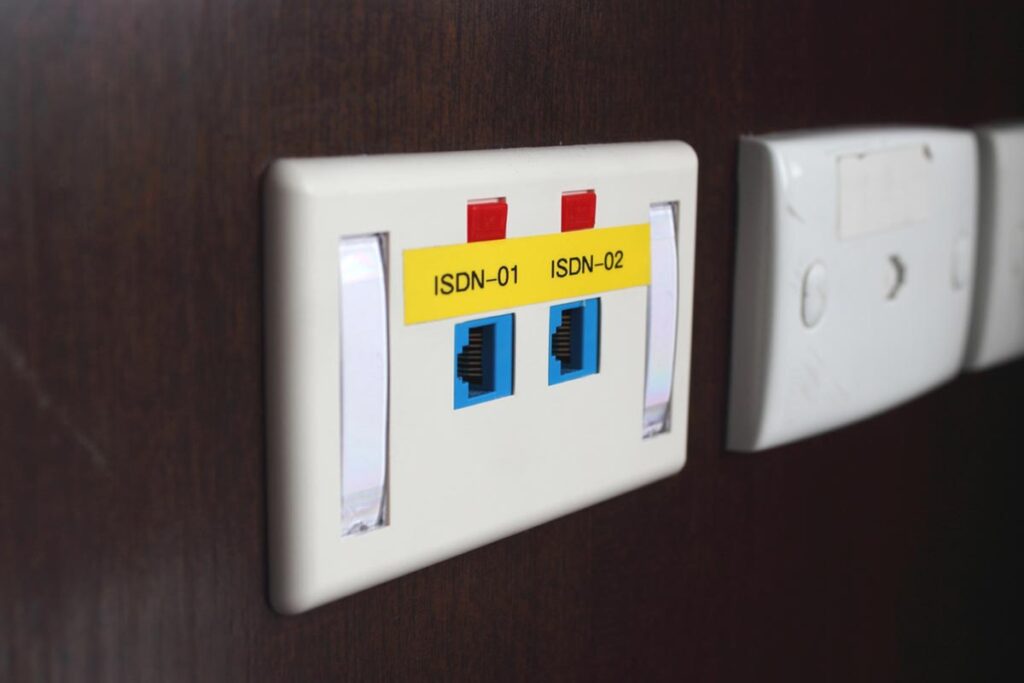SIP Trunks: The Definitive Guide
Find out how SIP Trunks are key to moving away from traditional PSTN to VoIP and IP PBX systems. Choose the right SIP Trunk Providers with our guidelines.

Looking for more information about how modern telecoms works? One important concept to understand is SIP Trunking. The traditional Public Switched Telephone Network (PSTN) – with its copper network and ISDN lines – is soon switching to be entirely based online. Understanding VoIP technology, and particularly how SIP Trunking can facilitate the switch from ISDN, will be key to many IT owners.
What is SIP Trunking?
SIP is just one of the possible “protocols” you can use for Cloud Phone Systems. It is similar to how HTTP functions with pages on the internet, and provides a way to convert voice signals into data that can be decoded by devices used by a caller.
SIP stands for Session Initiation Protocol, and is essentially a way to make and end connections for data and voice transfers over the internet. The ‘trunking’ element is a bit of a red herring, as a trunk used to refer to a bundle of phone lines shared between users. Modern trunking refers to a virtual link between your PBX and the standard phone network (the PSTN), using an internet connection.
Any business with a modern IP PBX (a PBX that supports the use of SIP to transfer data) also needs a way to connect their exchange to the wider PSTN. Traditionally (with older PBXs) this was done using ISDN. Now, with ISDN slowly being phased out, SIP Trunks are becoming the industry standard for connecting business phone networks over the internet.
Who should consider them?
In short, any business! If you already have an IP PBX, you’ll know (or should know) that SIP Trunks are an absolutely essential component. But if you’re new to phone systems or are changing from an analogue PBX, you have a choice to make between an on-premise (often shortened to “on prem” in industry lingo) IP PBX or a fully cloud hosted PBX system.
Using on premise hardware combined with SIP trunks is particularly suited to businesses with these characteristics:
IT managers and telephony specialists in house
On premise PBX systems need professionals to set up and maintain them. These can be agencies and managed service providers, but will also need at least one in-house contact with some knowledge of telephony.[Budget to spend on PBX hardware
On premise PBX systems, combined with relevant setup and maintenance, can be very expensive in the short term.
Significant Call Volume
Any business or site with a high volume of outbound and inbound calls need the flexibility and cost-effectiveness that SIP Trunking provides. Call centres, for example sales or support hubs, are highly likely to run more complex PBX systems supported by specialist high-volume SIP services.
For these businesses, getting the right SIP provider that fits their calling profile can mean serious cost savings in the long run, with the downside of spending more on hardware and setup in the short term.
For other types of businesses, hosted PBXs may be a better bet, as they allow a similar range of features and reliability with almost none of the maintenance and setup cost of on premise alternatives.
A good VoIP provider should always help you choose the best option to fit your business.
SIP Trunks vs SIP Channels
“Trunks” refer to traditional groups of cables that would link from local telephone exchange to exchange. With the internet, this process became virtual. A trunk is now a collection of assigned “channels”, each one of which can handle a set number of concurrent (happening simultaneously) calls. The number of channels you’ll need as a business is tied to the number of simultaneous calls you’ll be making and receiving. A good SIP provider will help you calculate this.
Channels are a key component of understanding the makeup of how trunks are packaged and provided. Every SIP Trunk contains a number of channels, which are essentially virtual versions of old fashioned telephone lines. Each channel allows two concurrent calls: one incoming or outgoing. This is important. If your business makes lots of calls but very rarely will have more than two concurrent calls, you won’t need more than one or two channels. If your business gets lots of inbound calls at once, you’ll need to think carefully about a large number of channels.

Why are businesses using them?
Ultimately, for any businesses still using ISDN, switching to IP-based telecoms services (using SIP as the conduit) is crucial. These benefits below are relevant to using SIP, but also any method of VoIP-based telephony.
Cost savings
With ISDN and traditional telephony, businesses often end up paying for capacity they never use. SIP Trunks are packaged far more accurately around your business’s actual usage. And, more importantly, once you’re set up with a SIP Trunk provider, line rental and calls are usually significantly cheaper. This – obviously – becomes even more important for businesses with high outbound call volumes, for example call centres, large sales teams and consultancies.
Geographic flexibility
SIP Trunks remove the location-based restrictions on telecommunications, meaning you can choose any number, regardless of geography. Perfect for international-based customers or suppliers. You can move office – even move country – and keep the same number.
Preparing for the future
ISDN has been an effective way for businesses to combine voice and data services with traditional lines. In the modern age, connectivity is king, and business telephony revolves around the power and reliability of a firm’s internet connection, as well as the efficiency of the services they’ve chosen. IP-based PBXs, whether on premise or cloud based, are essentially mandatory.
Control
Trunks are easy to scale up or down, depending on usage. For example, if your organisation suddenly experiences significant growth, don’t worry about physically installing new ISDN lines. Upgrading your number and capacity of trunks is simple and easy.
Unified Communications
From calls and texts, to emails, instant messaging and conferencing, SIP Trunks are the crucial building block in linking an organisation’s multiple methods of communications into one unified solution.
As trunking is a virtual, rather than physical installation, businesses should expect trunks to be set up and working quickly – even within 48 hours. In most cases organisations can just use their existing internet connectivity and infrastructure, with no need for extra installation.
SIP Trunk providers with significant experience and expertise can help get you the right combination of services quickly and easily. As you would expect, fast, reliable internet connections are crucial, as is having a modern IP PBX and IP enabled phones.
What do I need to consider?
It’s important to research SIP Trunk services with some key factors in mind:
How many concurrent calls will you need?
Remember concurrent calls dictates the number of channels you need, and is important to note that this includes both inbound and outbound calls . It’s good to have a basic understanding of your business’s concurrency, but don’t worry if this is tricky for you. One huge benefit of SIP services is their flexibility – adding and removing channels is easy.
How many minutes will you need?
An obvious question but how many calls do you actually make? Many providers will offer bundled minutes together with channels, but for some, making calls based on a set tariff may actually be cheaper. This would usually only be the case for very low volume call businesses.
How many new numbers will you need?
If you’re looking at a new provider, why not also get some new numbers? This may be particularly pertinent if you’re opening a new office in a different geography (potentially a different county or even country). SIP allows you to use the full benefits of VoIP services. For small businesses, this can allow them to appear much larger and more efficient than they are, for example creating an international support number (say, based in Germany) that is displayed to German customers and routes to a different extension or device. All of this can be done extremely cheaply and quickly.
Are you porting any existing numbers over?
Unless you’re a brand-new startup, you’ll probably have a pre-existing business number. Porting becomes essential as you don’t want to lose touch with your customers who are familiar with using a particular number for sales or support. Porting is simple but does take slightly longer than other elements of the SIP Trunk process, often lasting around 1-2 weeks.

What should I look for in a SIP Trunk provider?
As with any piece of critical business infrastructure, choosing the right service and provider is crucial. We know from conversations with our customers that they typically look at these key characteristics:
Price
OK, it’s obvious, but worth including. SIP Trunk pricing can vary massively from supplier to supplier. It’s really important to remember that it’s not just about the cost of channels (remember, they are determined by how many concurrent calls you make). You also need to know the provider’s call tariffs, as well as setup costs, number porting (moving your existing number over) and any hidden maintenance fees. All good providers should be clear about these costs well before you purchase. Examine any bundled minutes offers closely. As an example, our Sales team work closely with customers to make sure they’re getting the best price for their usage, rather than a large bundle they may not use.
Security
If your calls are sensitive, particularly relevant for businesses in sectors like financial services, healthcare and insurance, are you confident your provider has a secure connection and data policy?
Resilience and uptime
Make sure that your provider can show you uptime rates and has a clear monitoring policy in place. Ideally a real-time dashboard, alerts and 365 monitoring, (as we do here).
Frequently Asked Questions
What are SIP Trunks?
SIP stands for Session Initiation Protocol and is a way to make and end connections for data and voice transfers over the internet. A ‘trunk’ refers to a collection of phone lines shared between users. Designed to replace traditional phone lines, a SIP trunk is a virtual link between your PBX and PSTN using a broadband internet connection.
What is a high-volume SIP Trunk?
A high-volume SIP trunk runs on a separate dedicated platform, built for high volumes of traffic. It allows you to use the volumes you want without any issues.
What is a SIP channel?
A SIP channel is the capability to support incoming and outgoing calls. Every SIP trunk contains a number of channels, which are virtual versions of telephone lines. The number of channels you need depends on how many concurrent calls your business makes.
What’s the difference between SIP and VoIP?
VoIP or Voice Over Internet Protocol makes and receives phone calls over the internet or internal networks. SIP is an application layer protocol used to make, manage and terminate multimedia sessions, including voice, video and messaging. While SIP is an initiation in its own right, it is mainly used to support IP technology, like VoIP calls.
What requirements do I need for a SIP trunk?
The basic requirement for SIP trunks is an internet connection, with good bandwidth and speed. This is determined by the number of calls you expect to be making and other web applications. You also need an IP PBX that is compatible with the SIP protocol required. If you do not have this, you may require a SIP card or license installation.
Is there a limit on how many phone numbers I can have?
Not at all! With Flip, you can have as many phone numbers as you like from as many locations as you want.
How do I set up a SIP Trunk and how much does it cost?
Setting up SIP is extremely easy. Costs vary depending on which supplier you buy your SIP trunk from. Contact us today and we’ll set up everything for you and give you a competitive price.
Flip’s SIP services
Flip were one of the UK’s SIP Trunk pioneers, developing the technology when it was still relatively nascent. Our services are now trusted by thousands of SMEs and larger businesses around the UK.
What's Your Reaction?





















